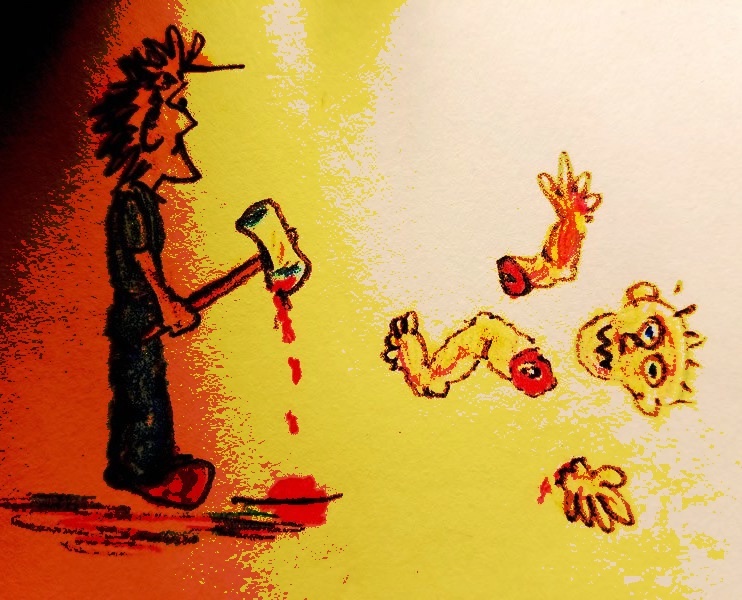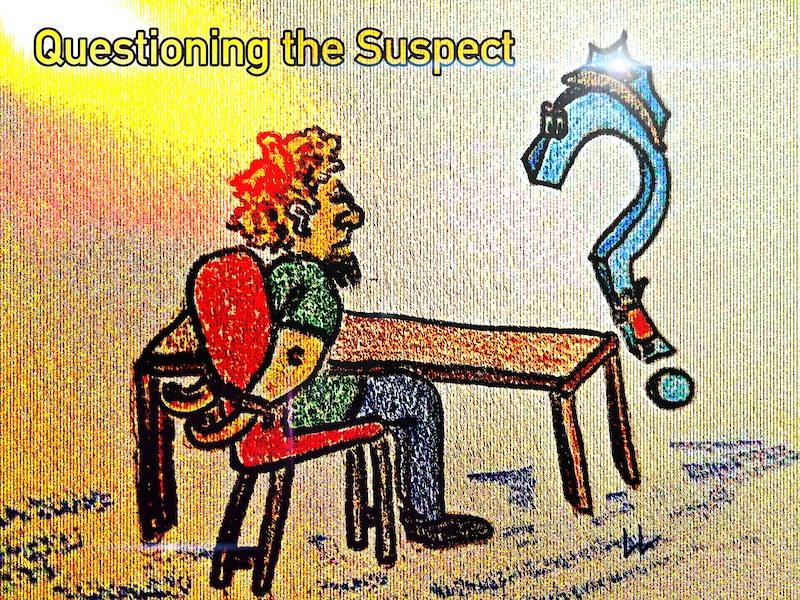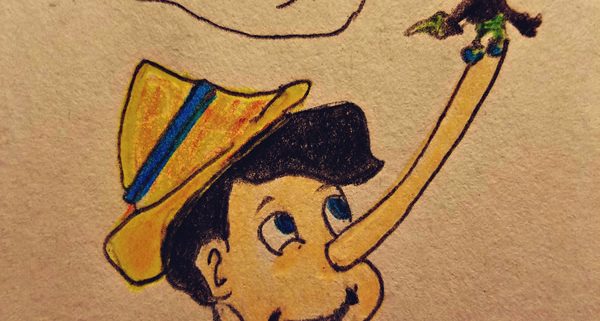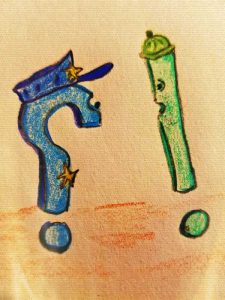Imagine that you, the police detective, have just arrived at the scene of a murder. Patrol officers, after their hurried, blue-light-and-wailing-siren response, immediately secured the area and have ten potential suspects standing by to speak with you. And that’s where you shine. You’re well-known for your abilities as an interrogator. But how exactly do you begin an interview or interrogation? What are your first words? How do you know they’ll be the right words?
Well, we all know that no two people are exactly alike, right? Therefore, the ten suspects most likely have stark differences in personalities, backgrounds, physical characteristics, habits, hobbies, and likes and dislikes.
Elaborate Disguises Help to Avoid Arrest!

Image #1 – Sometimes criminals use elaborate disguises (above) to conceal their identities from authorities.

Image #2 – Suspect prior to donning the disguise. See how easily it is for bad guys to avoid detection! No one could possibly recognize this man as being the same guy in image #1.
Now, speaking of dislikes, you can safely assume that one of the more common hostilities will be an aversion of police officers. Yes, believe it or not, there are actually people out there who just don’t think too kindly of the men and women who wear badges and uniforms (What a surprise!). And, along with the basic hatred of the blue polyester clothing and shiny shoes comes a huge portion of distrust. I know … more surprising news, huh?
A good interviewer, though, finds ways around all that hatred and lack of trust. And, by possessing the remarkable ability to overcome those obstacles, professional interviewers/interrogators are nearly worth their weight in gold when it comes to crime-solving. How do they do it? Well, for starters, to be a really good interviewer one must be a fantastic listener. I’ll repeat that for the “motor-mouths” out there. A good interviewer must be a good listener. A Good Listener. Good listener. Listen. Shhhh ………… listen. Stop talking and what? Ah, there you go.
Good Actors!
A savvy interviewer is also a human chameleon, a person who’s able to change tactics and topics as quickly as the suspect formulates and weaves new lies and new alibis. Good interviewers are also good actors.
The successful interviewer must possess the ability to detect subtle changes in a suspect’s voice, mannerisms, and attitude. The investigator must also know to never judge a person and their capabilities by his/her appearance. After all, criminals come in all shapes and sizes, and from all walks of life.
This also works in reverse. Investigators should never assume the worst about someone. Shabby clothing and a disheveled appearance are not positive indicators of criminal behavior. Like a suit and tie are not solid indicators of success. And these differences are part of why interviews and interrogation are often extremely important aspects of police investigations.
So let’s try a little exercise to see how you measure up as an interviewer. I think most of you will find that you’re already quite good at it, and you’ll soon see why.
The Crime
The body of 26-year-old movie starlet Iona Porche was found in a walk-in closet, not far from the bathtub in her bedroom suite. She was quite dead, and most definitely squeaky clean and embarrassingly nude. Well, except for the bath towel draped across her right leg.
Ms. Porche’s personal assistant told you that she’d been concerned about the assortment of “weirdos” hanging around her boss in recent weeks. The assistant also stated that Ms. Porche was extremely naive, and that perhaps some of the odd folks had been taking advantage of her boss’s generosity.
The really odd thing, she’d said, was that she’d overheard Ms. Porche involved in what sounded like a bitter argument with at least two males and one female (it was, after all, difficult to make out the voices with her ear tightly pressed to the wall). And, for the life of her, the assistant couldn’t understand why on earth Ms. Porche would allow those people in the room with her while she was taking a bath. “That sort of thing should be kept private,” were her exact words.

Iona Porche on the set of her latest hit movie, “Mamas Don’t Let Your Babies Attend Psycho Serial Killer Camp for Dumb Teens Who Can’t Outrun Men With Chainsaws and Machetes”
After thanking the assistant for what was basically a gossip-fest, you begin the interviews of the ten suspects. You know it’s important to first establish that you’re in charge, but you’ve also got to make the suspect feel comfortable with you. In other words, you’ve got to be the boss while assuming the role of best friend, mother, father, brother, cousin, and even their drunk uncle, if that’s what it takes to solve the case.
Yes, good investigators must have the ability to “walk the walk and talk the talk.” Finding common ground can definitely help start the dialog flowing. In fact, it’s a must in most instances.
 If the suspect is a green lizard-like man with horns, bumps under the skin where eyebrows should be, head to toe tattoos, and a forked tongue, then the good detective could possibly begin to build rapport by speaking about the silly Bugs Bunny tattoo he’d gotten on his right butt cheek after drinking one too many tequila shots the night of his twenty-first birthday. Doing so could be the ice-breaker needed to start the wagging of Mr. Lizard’s tongue.
If the suspect is a green lizard-like man with horns, bumps under the skin where eyebrows should be, head to toe tattoos, and a forked tongue, then the good detective could possibly begin to build rapport by speaking about the silly Bugs Bunny tattoo he’d gotten on his right butt cheek after drinking one too many tequila shots the night of his twenty-first birthday. Doing so could be the ice-breaker needed to start the wagging of Mr. Lizard’s tongue.
Now, with a conversation underway, the detective can ease into the real purpose of the meeting by asking simple questions, such as, “How did you know the victim? Was she your friend? A lover? A co-worker?” The idea is to establish a connection between the victim and the suspect, if there is one.
Okay, you have the basic concept. So what could you say to this next suspect that could be the start of a trust-building conversation?
Common Courtesy Goes a Long Way
Did you offer him a soft drink and candy bar because his breath smelled like root beer and chocolate? Sure, that’s a start. And please do look for the little things, not just an overall survey of the person seated in the interview room. There always more than meets the eye. Always. Don’t allow your detective to become mired in tunnel vision..

What you probably wouldn’t want to say to the suspect in the above photo is that you own a plaid cover for your motor home that’s practically the same size as his shirt. Besides, common courtesy goes a long way in police work, and in life in general. A badge is not a license to be mean. If a man, or woman, is thirsty … let them drink. If you’ve held them for many hours without food or drink, send someone to the nearest fast food joint for a burger. Get them some water or a soft drink. Besides, a simple act of human kindness could go a long way to building a rapport. And, well, it’s the decent thing to do. I know, the guy just butchered his neighbor’s grandpa. Still …

A little Fib Here or There
How about this next suspect? How do you get inside his head? Hmm … maybe that was a poor choice of words, but you know what I mean.
A great ice-breaker could be telling him about your cousin Sammy “The Nose” who used to entertain the neighborhood kids by shoving sewer rats up his nostrils. And yes, it is okay to tell a fib at this stage of the game—“I used to have a pet snake who looked just like yours. I named him ‘Slim’ after my dad. His nickname was Slim Jim.”
All of this is solid and basic information for a police detective, but did you notice that it’s also a great tool that could help writers add depth and personality to their characters? Readers want a personal connection to the people who live inside your books. They want to know them. To know what makes them tick. Why do they do what they do? When do they do it? Is it a compulsion? Are they obsessed? And it is the writer’s job to deliver answers to those questions by allowing the reader to follow the characters as they travel their daily journeys throughout a normal and believable world.
Sit the Character Across From You
 So, try it for yourself. Have your characters “sit” in a chair across from you and then find that one big thing that defines them—the forked tongue or the candy bar and root beer. Then continue to question your “suspect” until you “know” them as a person. You’ll soon find that with each question comes another layer, until soon you have a very real but fictional character sitting across from you. Of course, you may want to do this when no one else is at home to avoid being carted off by the net-wielding folks who run Nervous Hospitals.
So, try it for yourself. Have your characters “sit” in a chair across from you and then find that one big thing that defines them—the forked tongue or the candy bar and root beer. Then continue to question your “suspect” until you “know” them as a person. You’ll soon find that with each question comes another layer, until soon you have a very real but fictional character sitting across from you. Of course, you may want to do this when no one else is at home to avoid being carted off by the net-wielding folks who run Nervous Hospitals.
For now, you can practice your interviewing skills with this next potential suspect. Oh, I almost forgot, always remember to watch the eyes. They tell 70% of the suspect’s story. 10% is up to you. The other 20% lives in the imaginations of your readers. It’s up to you, though, to set those minds in motion.





